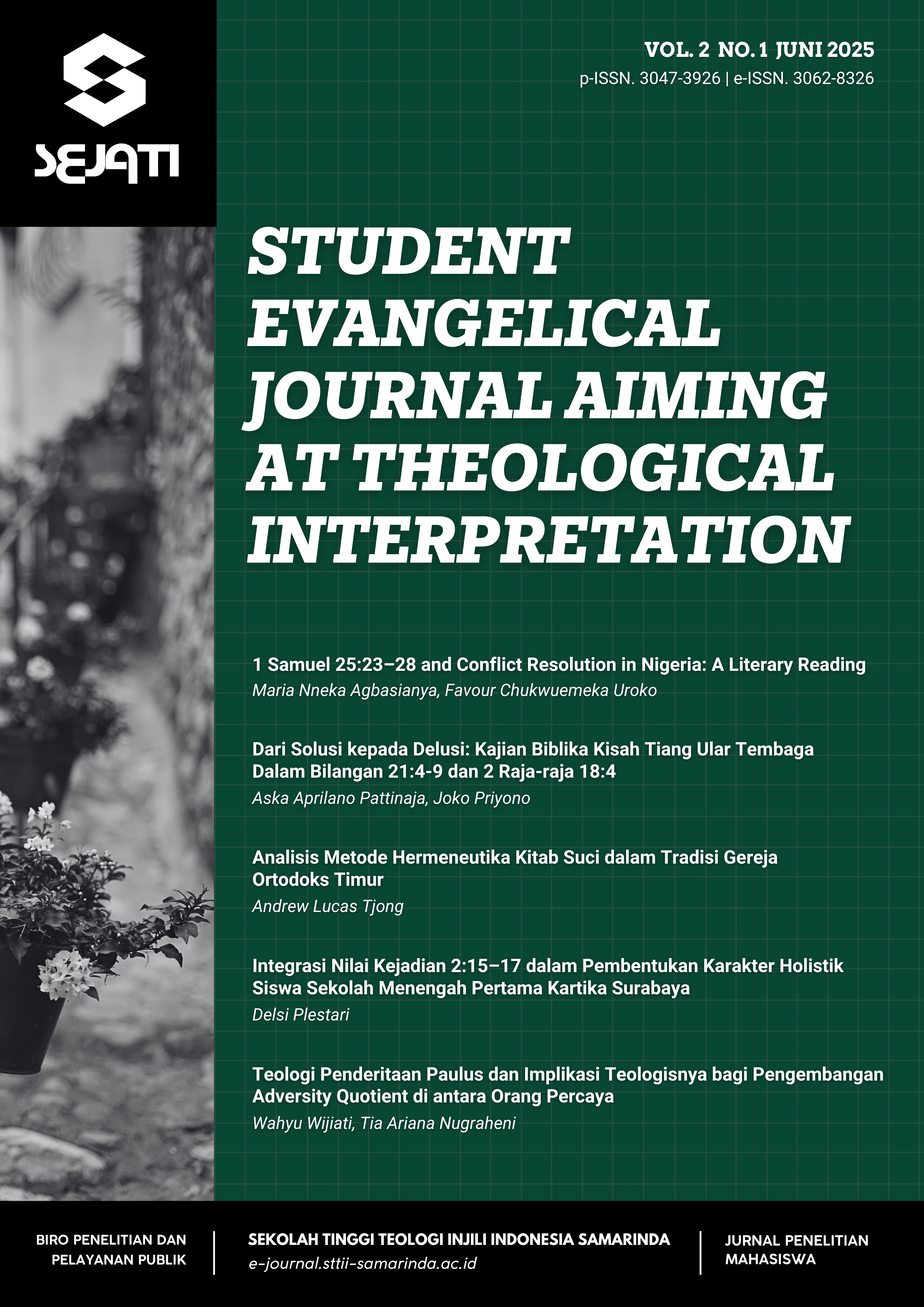Dari Solusi kepada Delusi: Kajian Biblika Kisah Tiang Ular Tembaga Dalam Bilangan 21:4-9 dan 2 Raja-raja 18:4
DOI:
https://doi.org/10.69668/sejati.v2i1.91Keywords:
Hezekiah, cooper serpent, solution, delusion, idolsAbstract
This research aims to explore the changing meaning of the copper snake from a symbol of salvific solution to a delusional object of idolatry. There is a gap in research because it was found that some previous studies only discussed historical, mythological, and cultural aspects without exploring the theological and implicative depth of the text. Based on the biblical hermeneutic method, this study produces three important findings: (1) God-given symbols of salvation can turn into idols if they lose their theological meaning; (2) True faith must be directed to God, not to religious means or traditions; (3) Spiritual reformation requires Hezekiah-like courage to destroy deviations for the sake of purifying faith. This study focuses on the relationship between faith and worship of the Israelites, and its relevance to the lives of believers today who often turn from true worship to modern forms of idols.
References
Al-Ajlouny, F., Khrisat, B., Al-Masri, E., Alyassin, H. A. H., Mayyas, A., & Kraishan, D. (2022). Early Bronze Snake Motifs on Pottery Vessels and Their Symbolism in Southern Levant. Mediterranean Archaeology and Archaeometry, 22(2), 67–96. https://doi.org/10.5281/zenodo.6576818
Alter, R. (2019). The Hebrew Bible: A Translation with Commentary, Vol. 1. W.W. Norton.
Amzallag, N. (2016). The Serpent as a Symbol of Primeval Yahwism. Semitica, 58(1), 207–236.
Awabdy, M. A. (2022). Snake Iconography, Mythology, and the Meaning of the Bronze Snake Image in Numbers 21:4–
and 2 Kings 18:4. The Asbury Journal, 77(2), 217–244. https://doi.org/10.7252/Journal.02.2022F.04
Bollhagen, J. (2013). Nehushtan and Serpent Symbolism in the Ancient Near East. Master of Sacred Theology Thesis,
(2), 503–508. https://scholar.csl.edu/stm
Brown, F., Driver, S. R., & Briggs, C. A. (2015). A Hebrew and English Lexicon of the Old Testament, with an Appendisx
Containing The Biblical Aramaic (F. Brown, S. R. Driver, & Charles A Briggs (eds.); 5th ed.). Oxford University Press.
Brueggemann, W. (2000). The book of 2 Kings. Smyth & Helwys.
Brueggemann, W. (2017). Theology of The Old Testament (Testimony, Dispute, Advocary). Fortrees Press.
Dendy Sugono. (2018). Kamus Besar Bahasa Indonesia (KBBI)-Pusat Bahasa (10th ed.). PT Gramedia Pustaka Utama.
Elliger, K., & Rudolph, W. (2020). Strong Dictionary - Biblia Hebraica Stuttgartensia (BHS) (K. Elliger & W. Rudolph
(eds.)). Deutsche Bibelgesellschaft Copyright held by the German Bible Society, in cooperation with the United Bible
Societies (UBS).
Frothingham, A. . L. . (2019). Babylonian Origin of Hermes the Snake-God , and of the Caduceus I. American Journal of
Archaeology, 20(2), 175–211.
Harris, R. L., Gleason L. Archer, J., & Waltke, B. K. (2019). Theological Wordbook of the Old Testament (Vol. 2) (R. L.
Harris (ed.)). Moody Publisher Press.
Hendel, R. S. (2019). Sacrifice as a Cultural System: The Ritual Symbolism of Exodus 24,3 — 8. Zeitschrift Für Die
Alttestamentliche Wissenschaft, 101(3), 366-390. https://doi.org/10.1515/zatw.1989.101.3.366
John H. Walton, Matthews, V. H., & Mark W. Chavalas. (2015). The IVP Bible Background Commentary Old Testament.
IVP Academic Inter Varsity Press.
John H Walton. (2018). Ancient Near Eastern Thought and the Old Testament (Introducing the Conceptual World of
the Hebrew Bible) (2nd ed.). Baker Academic Publishing Group. www.bakeracademic.com
John Stott. (2009). THE LIVING CHURCH. PT BPK Gunung Mulia.
John W. Cresswell. (2013). Research Design. Pustaka Belajar.
Joines, K. R. (2019). The Bronze Serpent in the Israelite Cult. Journal of Biblical Literature, 87(3), 245–237.
https://doi.org/10.2307/3263536
Kaiser, W. C. (2005). The Messiah in the Old Testament. Zondervan.
Keller, T. (2012). Center Church. Zondervan.
Levine, B. A. (2022). Ritual as Symbol: Modes of Sacrifice in Israelite Religion. In Sacred Time, Sacred Place (3rd ed.,
pp. 125–136). Penn State University Press. https://doi.org/10.1515/9781575065274-011
Münnich, M. (2018). The Cult of Serpents in Ancient Syria and Palestine during the Bronze and Iron Ages.
Harrassowitz Verlag.
Nahum M. Sarna. (2006). Exploring Exodus. Schocken Books.
Pattinaja, A. A., & Kiamani, A. (2025). Analisis Makna Frase “Lembu Jantan Kedua”: Studi Eksegese Hakim-Hakim 6:25-
Jurnal Teologi Berita Hidup, 7(2), 310–328. https://doi.org/10.38189/jtbh.v7i2.634
Pattinaja, A. A., & Talilah, S. R. (2024). Pentingnya persiapan diri untuk menjadi seorang pemimpin: studi hermeneutik
berdasarkan kisah “samgar” dalam hakim-hakim 3:31. CHARISTEO: Jurnal Teoogi Dan Pendidikan Agama Kristen,
(1), 1–16.
Peterson, C. (2005). Plays in Ten Thousand Places. Eerdmans.
Peterson, J. L., & Joines, K. R. (2016). Serpent Symbolism in the Old Testament: A Linguistic, Archaeological, and
Literary Study. Journal of Biblical Literature, 95(4), 658–659. https://doi.org/10.2307/3265592
Provan, I. W. (2015). 1 & 2 Kings - Understanding The Bible Commentary Series (W. W. Gasque, R. L. H. Jr., & R. K.
Johnston (eds.)). Baker Academic Publishing Group.
Rad, G. von. (2005). Old Testament Tehology (1st ed.). Baker Book House.
Raymond E. Brown. (2003). The Message of Deuteronomy. IVP Academic.
Salamon, H., & Goldberg, H. E. (2012). Myth‐Ritual‐Symbol. In R. F. Bendix & G. Hasan‐Rokem (Eds.), A Companion to
Folklore (pp. 119–135). Blackwell Publishing. https://doi.org/10.1002/9781118379936.ch6
Stuart, D., & Fee, G. D. (2021). Hermeneutik - Menafsirkan Firman Tuhan Dengan Tepat (Yosua Setio Yudo (ed.); 4th
ed.). Gandum Mas.
Swaggart, J. (2011). The Expositor’s Study bible (KJV) Concordance. B&H Publishing Group.
Tremper Longman III, & Raymond B. Dillard. (2015). An Introduction to The Old Testament (Issue 11). Zondervan.
Wenham, G. J. (2011). Numbers, Tyndale Old Testament Commentary. IVP Academic.
William. McKane. (2006). 2 Kings. SCM Press Ltd.
William L. Holladay. (2019). A Concise Hebrew and Aramaic Lexicon of The Old Testament (3rd ed.). William B.
Erdmans Publishing Company.
Wilson, L. S. (2010). Nachash and Sherah: Serpent Symbolism and Death, Life and Healing In The Ancient Near East
(Vol. 130, Issue 2) [Yale University]. http://dx.doi.org/10.1016/j.jaci.2012.05.050
Wright, C. (2007). Knowing Jesus Through the Old Testament,. IVP Academic.



 ENCE TOOLS
ENCE TOOLS









